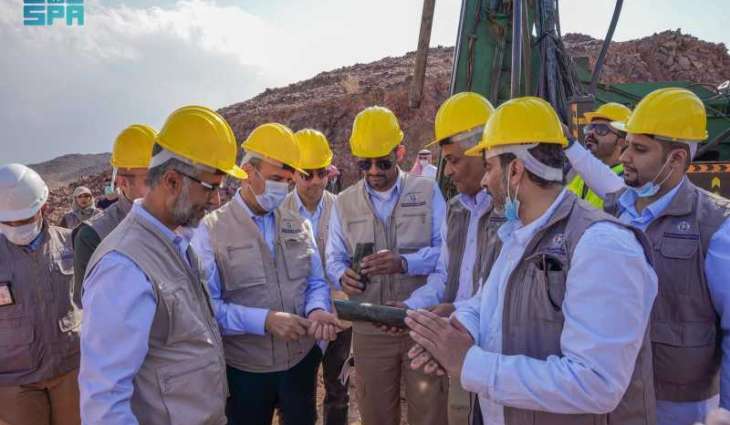Riyadh, October (پاکستان پوائنٹ نیوز 21 اكتوبر 2025ء) Over the past four years, Saudi Arabia has witnessed unprecedented progress in mineral exploration, making it one of the fastest-growing jurisdictions. The record achievement bolsters Saudi Vision 2030 goals, which identify mining as the third pillar of the national economy and a key driver of industrial growth and regional sustainable development.
The Kingdom's mining and mineral sector is witnessing growing investor confidence. In 2024 alone, private-sector spending on exploration licenses grew by 164%, to SAR770 million ($205 million) compared to SAR155 million ($41.3 million) in 2020, while government spending through geological programs grew from SAR11 million ($2.9 million) in 2020 to SAR180 million ($48 million) in 2024, a 16-fold increase.
The number of active exploration companies increased from six in 2020 to 226 in 2024, an encouraging 38-fold increase that indicates growing investor confidence and an increasing pool of local and international top-tier companies.
“Saudi Arabia’s mining sector is entering a new phase of accelerated growth and maturity,” said Industry and Mineral Resources Vice Minister for Mining Affairs Eng. Khalid Al-Mudaifer.
“Progressive legislation, focused national programs, and transparent, sustainable international partnerships are part of the enablers of this unprecedented growth. The Kingdom is fast-becoming one of the most attractive destinations for mining investment, not only because of the scale of our resources but because of our ability to manage them with efficiency and reliability,” the vice minister added.
Exploration spending grew from SAR 105 ($28) per square kilometer in 2020 to SAR539 ($143.7) in 2024, moving the Kingdom’s global ranking from 20th to 12th place. It represents a compound annual growth rate of 50%, arguably one of the highest globally.
Over 70% of the Kingdom’s total exploration spending was expended on grassroots projects in new and underexplored areas, marking the highest proportion among 21 countries included in the global comparison.
The report indicated that advanced-stage projects closest to potential mine development accounted for the largest share of 2024 spending, at SAR349 million ($93 million), followed by early-stage exploration at SAR263 million ($70.1 million). The balance indicates a healthy pipeline of projects moving from discovery to development, supported by strong geological data and a transparent licensing regime.
Meanwhile, committed exploration spending across the Kingdom’s eight tender rounds reached SAR1.2 billion ($320 million), with two-thirds of participants representing foreign or consortium bidders from countries such as Australia, Canada, China, India, Indonesia, and the United Kingdom. The number of auctioned sites increased from 1 site during the first auction round in 2022 to 29 sites during the latest auction this year.
The sector has attracted strong interest from leading global mining companies and consortia, with foreign investors accounting for 66% of total mining investment.
--Total exploration spending on licenses increased from SAR292 million to SAR770 million, reflecting intensified field activity.
--Drilling activity remained the largest contributor, increasing from SAR 152 million in 2023 to SAR230 million in 2024.
--From a geological perspective, the Kingdom possesses a rich mineral resource base that includes 933 exploration location at various stages of development, comprising 691 locations for gold and associated minerals and 242 locations for base metals such as zinc and copper.
--Preliminary estimates of mineral potential amount to approximately 67 million ounces of gold, 3.87 million tons of copper, and 5.24 million tons of zinc, with mineral reserves making up at around 12 million ounces of gold, 60 thousand tons of copper, and 33 thousand tons of zinc. These figures reflect the richness of the Kingdom’s mineral sector and underscore its potential to be a key player in global supply chains, particularly in clean energy and downstream industries.
Such growth reflects the strong integration between the private sector and government entities, led by the Saudi Geological Survey (SGS), which is developing a comprehensive national geological database through the Regional Geological Survey Program (RGP) and the Accelerated Exploration Program (AEP) to identify mineral potential and accelerate data collection and analysis.
Saudi Arabia’s mining sector has witnessed a remarkable leap in investment attractiveness, according to the 2024 Fraser Institute report. The Kingdom advanced from 104th to 23rd place globally over the past decade, outperforming many prominent mining destinations in Asia and Latin America.
The report also highlighted that Saudi Arabia ranked first globally in the pace of improvement of its overall investment environment (2018–2023), second worldwide in the mineral licensing policy perception index, and entered the top 10 countries in mining fiscal policy. Additionally, the Kingdom made significant progress in the regulatory and legislative framework index, positioning itself among the world’s best jurisdictions.
The achievements reflect the growing international confidence in Saudi Arabia’s investment environment and reaffirm its emergence as a rising global power in the mining sector.




